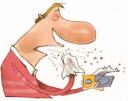Back on March 9th, I came down with a cold or a flu. Just today, on the 15th, I awoke feeling half-way normal again.
Maybe it is because I’m getting older, I don’t know, but this was one of the worse I’ve ever had. This past week, Tuesday, Wednesday, Thursday and Friday were like dreams from hell.
The only work I did was to sit at the computer and do stuff and I couldn’t do that for more than an hour or so before I had to go lay down again for an hour to recover some strength.
We’re talking severe congestion, sinus pressure, muscle aches, kidney aches, all previous injury sites aching, fever flashes, and dizziness when turning the head.
I have, personally, this week put the toilet paper industry back into profitable space with the amount of nose blowing I’ve done.
People are so casual about colds.  I had to make a few trips out into the world during the week. At each place, I was as antiseptic as I could be and when ever I had to deal with someone, I told them I had a cold and that they should take precautions after we’d done our business. Precautions like wiping down the credit card machines and/or washing their hands and etc.  Some were grateful and did so.
One lady told me that in ten years of working with the public, daily, I was the first person who’d ever warned her like this. But, another fellow, after several minutes of talking about it, said he wasn’t worried and if he got it, he got it, and he did nothing. Amazing.
My wife and I are careful.  We both carry hand-sanitizer and try to remember to use it after all contacts with the public, doorknobs or whatever.  We wash our hands whenever we come in from the outside.  If customers how up here that look snotty, we watch their every move and lysol the ground they walked on as they leave.
In spite of all of this, I got nailed someplace in the last two weeks. Someone snotty touched an object that I later touched and then that material made it into my system – and I was hosed.
When one of us gets sick here, we immeditely go into what we call ‘isolation mode’.  If I’m the one who is sick (usually the case – as my wife is far more careful than I am), then I begin to sleep in the guest room, use only the upstairs bathroom, enter an exit the house through a different door that she uses. I touch nothing in the kitchen, or, if I must, it is via paper towels that I’ve only touched on one side and the object in question is, of course, on the other side.
Every move and every object is looked at as a possible vector for the virus to get from me to her.
Usually, we’re successful and she avoids getting what I’ve got. Â So far, this time, she’s symptom free (knock on wood) and I hope it stays that way. Â We open for spring here on April 4th, which is about two weeks away, and we are both maxed out with things to do that MUST be done.
Moral/s of this story:
- Don’t be casual when you have a cold or flu. Every object you touch can be a vector via which the virus moves onto the next person and so the chain continues. The ideal is to let the infection you have stop with you – and break the chain.
– If you are healthy, try to stay that way. Realize that most folks ARE careless and causal about colds and flus and that infection is always around you waiting for a chance to use you as its next playground. Carry hand sanitizer and use it.  Think about the objects you touch as you move through your day and who else might have touched them.
– Do not go into work if you are sick unless you absolutely have no choice.  If you have to be in contact with the public – warn them.  The last time my wife got sick, it was because the checkout lady at the local supermarket was working with a cold and handled all of our food items as she checked us out.  My wife raised holy-hell with the store supervisor – but the store has no policies to allow employees to stay home with pay if they are sick.  It’s cheaper for the corporate bean-counters to make them work if they want to get paid – and too bad for the unwitting public.
-Folks, we are our own worst enemies with colds and flus – wake up.
– Postscript (later the same day):  It looks like, after six days in the same hours with me in close quarters, Sharon may not have escaped getting this virus in spite of our best efforts.  She says she’s feeling off and getting something in her throat. That’s a bummer.  I really hate to see anyone have to go through this one.
